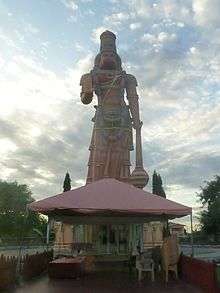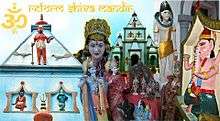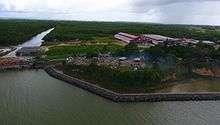Hinduism in Trinidad and Tobago
 | |
| Total population | |
|---|---|
|
240,100 (2011) 18.2% of the Trinidad and Tobago Population | |
| Regions with significant populations | |
| Trinidad and Tobago, United States, Canada, United Kingdom | |
| Languages | |
| Sanskrit · Prakrit · Pali · Hindi · Tamil (for religious texts and prayers) · English · Hindi · other Indian Languages | |
| Religion | |
| Hinduism |
| Historical population | ||
|---|---|---|
| Year | Pop. | ±% |
| 1990 | 292,786 | — |
| 2000 | 285,517 | −2.5% |
| 2011 | 240,100 | −15.9% |
| Year | Percent | Increase |
|---|---|---|
| 2000 | 22.5% | - |
| 2011 | 18.2% | -4.3% |





Hinduism is the second largest religion in Trinidad and Tobago. Hindu culture arrived in 1845 in Trinidad and Tobago.[1] In the 21st century, pro Hindu parties were elected.[2] In the 2011 census, There are 240,100 declared Hindus in Trinidad and Tobago. There are also various temples in Trinidad and Tobago to accommodate Hindus.
History
A decade after slavery was abolished in 1834, the British government gave permission for the colonists to import indentured labor from India to work on the estates. Throughout the remainder of the century, Trinidad's population growth came primarily from Indian laborers. By 1871, there were 27,425 Indians, approximately 22 percent of the population of Trinidad and Tobago; by 1911 that figure had grown to 110,911, or about 33 percent of all residents of the islands.
During the initial decades of Indian indenture, Indian cultural forms were met with either contempt or indifference by the non-Hindu majority.[3] Hindus have made many contributions to Trinidad history and culture even though the state historically regarded Hindus as second class citizens. Hindus in Trinidad struggled over the granting of adult franchise, the Hindu marriage bill, the divorce bill, cremation ordinance, and others.[3] Cremation was allowed in 1953.[4]
After Trinidad's independence from colonial rule, Hindus were marginalized by the African-based People's National Movement. The opposing party, the People's Democratic Party, was portrayed as a "Hindu group", and other anti-Hindu tactics were used against them. Hindus were castigated as a "recalcitrant and hostile minority".[3] Hindus were alienated by such communal groups. The support of the PNM government to creole art forms in Carnivals, while their public rejection and ridicule of Hindu art forms, was a particular source of contention for the Hindu minority. The displacement of PNM from power in 1985 would improve the circumstances
There has been persistent discontent among the Hindus with their marginalization. Many groups portray Hindus as "clannish, backward and miserly". During the General Elections of 1986, the absence of the Bhagvad Gita and the Quran at polling stations for required oath-taking was interpreted as a gross insult to Hindus and Muslims. The absence of any Hindu religious texts at the official residence of the President of Trinidad and Tobago during the swearing in of the new Government in 1986 was perceived as another insult to the minority communities since they were represented in the government. The national education system and curriculum have been repeatedly accused of such majority-oriented symbolism. The use of discernibly oriented prayers at Government schools, the non-representation of Hinduism in approved school textbooks, and the lack of emphasis on Hindu religious observance evoked deep resentment from the Hindu community. Intensified protests over the course of the 1980s led to an improvement in the state's attitudes towards Hindus.[3]
The divergence of some of the fundamental aspects of local Hindu culture, the segregation of the Hindu community from Trinidad, and the disinclination to risk erasing the more fundamental aspects of what had been constructed as "Trinidad Hinduism" in which the identity of the group had been rooted, would often generate dissension when certain dimensions of Hindu culture came into contact with the State. While the incongruousness continue to generate debate, and often conflict, it is now tempered with growing awareness and consideration on the part of the state to the Hindu minority.[3] Hindus have been also been subjected to conversions by Christian missionaries, specifically the evangelical and Pentecostal Christians. Such activities reflect racial tensions that at times arise between the Afro-Trinidadian and Indo-Trinidadian communities.[5]
Sects, Denominations, and Organizations
Sanātanī (Orthodox Hinduism); Sanatan Dharma Maha Sabha is the major Sanātanī (Orthodox Hindu) group in Trinidad and Tobago (Smartism, Vaishnavism, Shaivism, Shaktism, Shrautism, Suryaism, Ganpatism, Kaumaram), Chinmaya Mission, Advaita Vedanta, Neo-Vedanta, Arya Samaj, SWAHA, Kabir Panth, Sai Baba (Sathya Sai Baba movement and Shirdi Sai Baba movement), Ayyavazhi, Ramakrishna, Radha Soami, Swaminarayan Sampraday, International Society for Krishna Consciousness (Hare Ramas Hare Krishnas), Ananda Marga, Brahma Kumaris, Prarthana Samaj, Brahmo Samaj.
Culture
Mandirs
Hindu Organizations and Holidays
The major Hindu organisation in Trinidad and Tobago is the Sanatan Dharma Maha Sabha founded by Shri Bhadase Sagan Maraj ji, and led by his son-in-law Mr. Satnarayan Maharaj ji. The Hindu festival of Diwali is a public holidays in Trinidad and Tobago, and along with Phagwah, it is widely celebrated in Trinidad and Tobago by people of all races, ethnicities, cultures, and religions. Others Hindu festivas such as: Ram Navami, Sita Navami, Vivaha Panchami, Maha Shivaratri, Navaratri, Teej, Karwa Chauth, Chhath Puja, Krishna Janmaashtami, Radhastami, Dussehra, Jivitputrika, Kartik Purnima, Guru Purnima, Vat Pournima, Tulsi Vivah, Makar Sankranti, Ahoi Ashtami, Pitru Paksha, Thaipusam, Hanuman Jayanti, Mahalakshmi Vrata, Ganesh Chaturthi, Ganesh Jayanti, Sitalsasthi, Gowri Habba, Gangaur, Bhai Dooj, Raksha Bandhan, Gandhi Jayanti, Vasant Panchami, Godavari Pushkaram, Skanda Sashti, Mesha Sankranti, Pancha Ganapati, Buddha Purnima are also celebrated.
Caste
As in other parts of the Caribbean (Guyana, Suriname, Jamaica, Belize, Saint Lucia, Saint Vincent and the Grenadines, Grenada, Guadeloupe, and Martinique), South Africa, Fiji, and Mauritius, caste distinctions are all but forgotten among Trinidadian Hindus. Considerations of caste became less important in choosing a spouse largely because there were so few women among the Indian indentured workers.
Cremation
Cremation is permitted at three cremation sites in Mafeking (Mayaro-Rio Claro), South Oropouche (Siparia) and Waterloo (Couva-Tabaquite-Talparo).
Famous Trinidadian Hindus
- Ravi Bissambhar
- Kamla Persad-Bissessar [6]
- Neil Bissoondath
- Dole Chadee (born Nankissoon Boodram)
- Capildeo family
- Pundit Capil Deo Dubey
- Rudranath Capildeo
- Simbhoonath Capildeo
- Vahni Capildeo
- Rajindra Dhanraj
- Daren Ganga
- Rikki Jai
- Parvati Khan
- Bhadase Sagan Maraj
- Devant Maharaj
- Krishna Maharaj
- Pundit Munelal Maharaj
- Ramesh Maharaj
- Satnarayan Maharaj
- Valene Maharaj
- Roodal Moonilal
- Seepersad Naipaul
- Shiva Naipaul
- V.S. Naipaul
- Basdeo Panday
- Ria Carlo (née Persad)
- Lakshmi Persaud
- Rajendra Persaud
- Sundar Popo
- Neeshan Prabhoo
- Ajeet Praimsingh
- Anantanand Rambachan
- Surujrattan Rambachan
- Raymond Ramcharitar
- Drupatee Ramgoonai
- Anand Ramlogan
- Heeralal Rampartap
- Arnold Rampersad
- Adrian Cola Rienzi (Krishna Deonarine Tiwari)
- Adesh Samaroo
- Lall Ramnath Sawh
- Lakshmi Singh
- Pundit Sahadeo Tiwari
- Pundit Ramdath Vyas
- Rakesh Yankaran
See also
References
- ↑ http://www.laht.com/article.asp?ArticleId=2389343&CategoryId=14092
- ↑ http://economictimes.indiatimes.com/nri/nris-in-news/trinidad-and-tobago-pm-kamla-persad-commemorates-170-years-of-indian-arrival/articleshow/47480224.cms
- 1 2 3 4 5 Singh, Sherry-Ann, Hinduism and the State in Trinidad, Inter-Asia Cultural Studies, Volume 6, Number 3, September 2005, pp. 353-365(13)
- ↑ "Cremation act" (PDF). Ministry of Legal Affairs. Retrieved 2016-12-30.
- ↑ Trinidad and Tobago International Religious Freedom Report 2002. U.S. Department of State. Accessed 2008-05-18.
- ↑ Kamla_Persad-Bissessar

